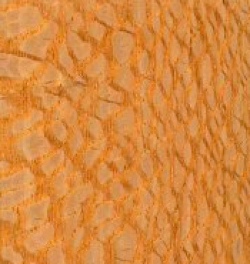The Contemporary Rocking Chair Wows the Eye with Exotic Hardwoods and Accents.
A contemporary rocking chair can really sizzle with style by the proper use of exotic hardwoods in its construction.

"More is better!", the old axiom says, but that is not always the case, especially when it comes to custom rockers.
Here are some important things to consider when deciding to choose an exotic hardwood for your rocking chair.
- What is an exotic hardwood anyway?
The term "exotic hardwoods" is a catch-all phrase that has a couple of meanings. Its primary meaning concerns hardwoods that come from overseas, or Central and South America like this Brazilian lacewood (above). It can also mean woods that originate anywhere outside of North America, for that matter.
The other less common meaning is for a strangely grain-patterned wood native to North America or Europe. Sometimes, even small domestic trees such as the dogwood or holly are considered "exotic" by folks because they are so rare to find at the saw mill.
The bottom line is that the term "exotic" is usually more descriptive of the far off locality of the wood's origin, although not always.

- Here's an example. Black walnut is a beautiful and common North American hardwood used for contemporary rockers. It's not considered "exotic".
Burled walnut, however, is a very rare, wild-grained wood that comes from a diseased domestic walnut tree. Therefore, some folks categorize it as "exotic" because of rarity rather than location.
- Are exotic hardwoods just as good for building a contemporary rocking chair as native hardwoods?
Yes, exotic hardwoods (those grown outside North America) can make excellent rocking chairs. One of the most famous woods used during the past 3 centuries is the exotic hardwood mahogany. It is used for the contemporary rocking chair as well as other fine furniture.
Some species of exotics, however, are less-suitable for use in structural elements of the rocker because of their characteristics. Some are too heavy and dense, or of such wild grain pattern that their structure has almost no stability or strength.
Some are even toxic when sawn, or so resinous that they will not take a finish well at all. It's important to be cautious and talk to the craftsman about the practicality of using these interesting woods in your contemporary rocking chair.
- If a little is good, is a lot better when it comes to certain exotic hardwoods?
Not always, as mentioned above. An important thing to remember is that a contemporary rocking chair has several elements that work together to create its greatest appeal. If a wild-grained burl wood is used for the entire seat, for instance, it would visually "overpower" other equally important aspects of the chair, like style, finish, comfort, etc.
From a structural standpoint, the rocker could be unsafe to sit in because of the weak nature of the crazy wood grain. This is where using good discretion plays a role. By using some exotic woods as accents, the overall appeal of the chair is enhanced without overpowering any other important aspect.
I use a complementary accent wood in the seats, runners and side rails of rockers. These add sophistication and visual interest for you to enjoy without the chair screaming "Look at me! Look at me!"
Something else to keep in mind when choosing an exotic hardwood for use in your contemporary rocking chair is the overall benefit you will receive.
Do you want it to bring a calming sense to your mind and body? Or, are you more interested in loud "eye-candy"? Or do you want both?
Experience has shown that a visually and structurally balanced rocker with elements working together gets used the most.
For more discussion about the wonderful world of exotic hardwoods and how they can be used most effectively in your custom rocking chair, contact me.
Return from Exotic Hardwoods and Accents to Materials Selection.
Return from the contemporary rocking chair Exotic Hardwoods and Accents to Home.



